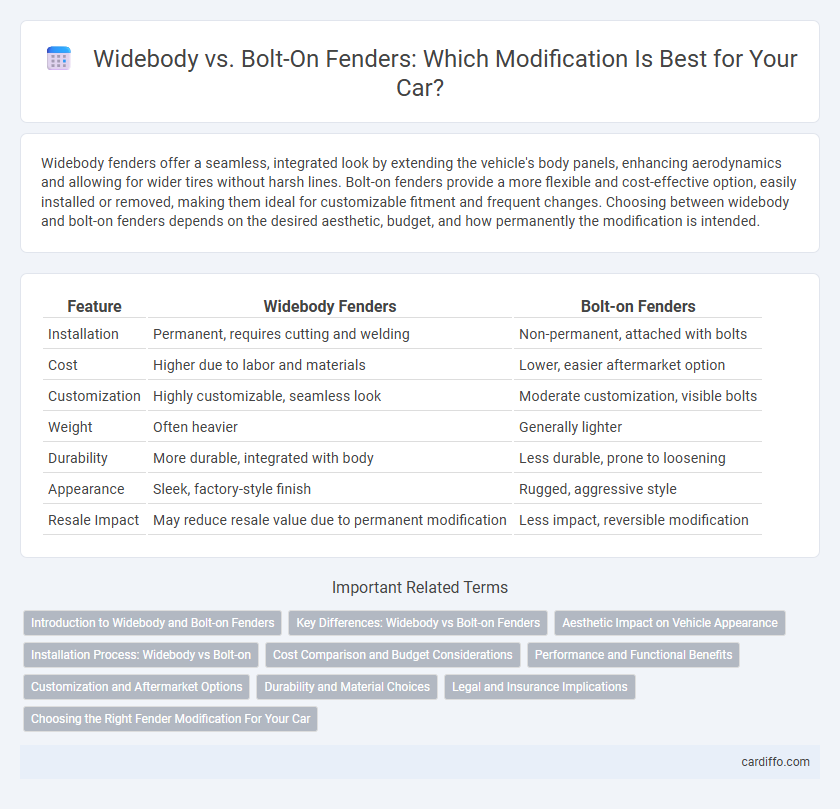Widebody fenders offer a seamless, integrated look by extending the vehicle's body panels, enhancing aerodynamics and allowing for wider tires without harsh lines. Bolt-on fenders provide a more flexible and cost-effective option, easily installed or removed, making them ideal for customizable fitment and frequent changes. Choosing between widebody and bolt-on fenders depends on the desired aesthetic, budget, and how permanently the modification is intended.
Table of Comparison
| Feature | Widebody Fenders | Bolt-on Fenders |
|---|---|---|
| Installation | Permanent, requires cutting and welding | Non-permanent, attached with bolts |
| Cost | Higher due to labor and materials | Lower, easier aftermarket option |
| Customization | Highly customizable, seamless look | Moderate customization, visible bolts |
| Weight | Often heavier | Generally lighter |
| Durability | More durable, integrated with body | Less durable, prone to loosening |
| Appearance | Sleek, factory-style finish | Rugged, aggressive style |
| Resale Impact | May reduce resale value due to permanent modification | Less impact, reversible modification |
Introduction to Widebody and Bolt-on Fenders
Widebody fenders are integrated extensions of a vehicle's body, designed to accommodate wider wheels and enhance aerodynamics while providing a seamless, factory-like appearance. Bolt-on fenders offer a more modular approach, with panels attached using bolts for easy installation and removal, allowing for flexible customization and repair. Both types improve tire clearance and vehicle stance but differ in complexity, cost, and visual impact.
Key Differences: Widebody vs Bolt-on Fenders
Widebody fenders are integrated into the car's body, offering a seamless, factory-like appearance with enhanced aerodynamics, while bolt-on fenders are aftermarket additions attached with visible bolts for easier installation and removal. Widebody kits typically require cutting and welding, providing a permanent and robust solution suitable for aggressive stance and performance upgrades, whereas bolt-on fenders offer flexibility for temporary customization without major structural changes. The choice impacts weight, durability, and maintenance, with widebodies generally heavier but more durable, and bolt-ons lighter, allowing quicker swaps for different styles or track setups.
Aesthetic Impact on Vehicle Appearance
Widebody fenders create a more aggressive and muscular stance by significantly widening the vehicle's profile, enhancing its visual presence and convey a race-inspired look. Bolt-on fenders offer a subtler aesthetic upgrade, maintaining the stock shape while providing clean, modular enhancements that emphasize practicality and customization flexibility. Both styles influence the vehicle's appearance but cater to different visual preferences and levels of modification intensity.
Installation Process: Widebody vs Bolt-on
Widebody fenders require extensive cutting, welding, and custom fitting to seamlessly integrate with the vehicle's frame, demanding professional skills and more installation time. Bolt-on fenders offer a straightforward installation process using existing mounting points, making them more accessible for DIY enthusiasts and quicker to install. The complexity of widebody installation often results in higher labor costs and longer vehicle downtime compared to bolt-on fender kits.
Cost Comparison and Budget Considerations
Widebody fenders generally demand higher costs due to extensive fabrication, custom fitment, and painting, often ranging from $1,000 to $3,000 or more for a complete set. Bolt-on fenders offer a more budget-friendly alternative, with prices typically between $300 and $1,000, as they require less modification and labor. Budget considerations should factor in installation complexity and potential additional work required for widebody kits, impacting overall expenses significantly.
Performance and Functional Benefits
Widebody fenders improve aerodynamics and allow for wider tires, enhancing grip and cornering stability during high-performance driving. Bolt-on fenders provide easier installation and greater flexibility for customization without extensive fabrication. Both options increase wheel clearance, but widebody fenders offer superior structural integrity and better airflow management for improved track performance.
Customization and Aftermarket Options
Widebody fenders offer extensive customization by allowing significant expansion of the vehicle's width, enabling the addition of larger wheels and tires for improved performance and aggressive aesthetics. Bolt-on fenders provide a more accessible aftermarket option, allowing easier installation and removal while maintaining original body lines, making them ideal for enthusiasts seeking moderate customization without permanent modification. Both options cater to different customization needs, with widebody kits appealing to extreme visual and functional upgrades, whereas bolt-on fenders offer flexibility and reversible enhancements.
Durability and Material Choices
Widebody fenders are typically constructed from durable materials such as fiberglass or carbon fiber, providing superior strength and resistance to impacts compared to bolt-on fenders made from stamped steel or ABS plastic. The seamless integration of widebody fenders enhances structural integrity, reducing the likelihood of cracks or detachment over time. Bolt-on fenders offer easier replacement and customization but may be more prone to wear and deformation under extreme driving conditions.
Legal and Insurance Implications
Widebody fenders often require professional certification to meet legal standards, ensuring compliance with local vehicle modification laws, while bolt-on fenders typically align with OEM specifications, simplifying insurance approval. Insurance companies may increase premiums or deny coverage if widebody modifications are undocumented or cause alterations outside factory safety parameters. Bolt-on fenders, being reversible and less invasive, usually present fewer legal hurdles and maintain existing insurance conditions more easily.
Choosing the Right Fender Modification For Your Car
Widebody fenders significantly increase vehicle width by replacing original panels, providing superior space for wider tires and aggressive stance, ideal for performance and aesthetic enhancements. Bolt-on fenders offer a simpler, reversible modification by attaching over existing bodywork, making them a cost-effective option for those seeking moderate width adjustments without extensive fabrication. Selecting the right fender modification depends on desired appearance, budget, and whether permanent structural changes or flexibility for future alterations are prioritized.
Widebody vs Bolt-on Fenders Infographic

 cardiffo.com
cardiffo.com